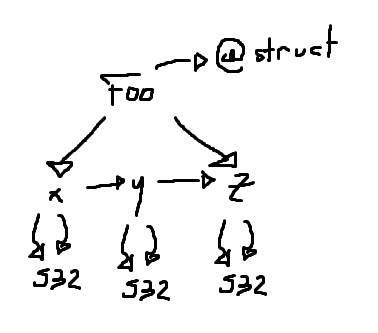Metawho?
Metadesk lets you create structured text files, like C code or HTML, driven by information you supply in Metadesk data structures. It's useful in automating some types of 'metaprogramming' or 'document building' tasks. You can use Metadesk to generate code for serializing networking messages, or to generate HTML for your blog.
This is a sample written in the Metadesk format.
@struct Foo:
{
x: S32,
y: S32,
z: S32,
}To you, this might look like a variation on a C struct declaration. Metadesk, however, does not recognize any such concept. Metadesk sees a tree of nodes, like this.
Consider this minimal example which goes through each top level declaration, listing its tags and children.
int main(int argument_count, char **arguments)
{
MD_String8 example_code = MD_S8Lit("@struct Foo:\n"
"{\n"
" x: S32,\n"
" y: S32,\n"
" z: S32,\n"
"}\n\n");
MD_Node *code = MD_ParseWholeString(MD_S8Lit("Generated Test Code"), example_code);
/* iterate through each top-level node */
for(MD_EachNode(node, code->first_child))
{
printf(" - %.*s\n", MD_StringExpand(node->string));
/* print the name of each of the node's tags */
for(MD_EachNode(tag, node->first_tag))
{
printf(" - Tag %.*s\n", MD_StringExpand(tag->string));
}
/* print the name of each of the node's children */
for(MD_EachNode(child, node->first_child))
{
printf(" - Child %.*s\n", MD_StringExpand(child->string));
}
}
return 0;
}output:
- Foo
- Tag struct
- Child x
- Child y
- Child z
The MD_StringExpand and MS_S8Lit macros are necessary because Metadesk
stores strings as a pointer and a length, rather than storing only a pointer
and relying on null termination, as standard C literals and the CRT assume.
The example above serves well to introduce you to the API calls, but doesn't make evident the tree structure that MD_Nodes occupy. Imagine if you replaced the outermost for loop with a call to this function:
void recurse(MD_Node *node, int indent)
{
for(int i = 0; i < indent; i++) printf(" ");
MD_String8 kind = MD_StringFromNodeKind(node->kind);
printf("- %.*s %.*s\n",
MD_StringExpand(kind),
MD_StringExpand(node->string));
for(MD_EachNode(tag, node->first_tag)) recurse(tag, indent + 2);
for(MD_EachNode(child, node->first_child)) recurse(child, indent + 2);
}If you supplied 0 as the initial indentation, the output would be like this:
- File `DD Parsed From "Generated Test Code"`
- Label Foo
- Tag struct
- Label x
- Label S32
- Label y
- Label S32
- Label z
- Label S32
Compare this to the tree diagram from before; they should match up 1:1 (modulo the File node).
Metadesk has helpers built in for common formats, like C structure declarations.
You could have replaced that outermost for loop in the original example with this
one, instead of the call to recurse.
for(MD_EachNode(node, code->first_child))
{
if(MD_NodeHasTag(node, MD_S8Lit("struct")))
{
MD_OutputTree_C_Struct(stdout, node);
}
}Then the output would be
typedef struct Foo Foo;
struct Foo
{
S32 x;
S32 y;
S32 z;
};Details
Sets
The colon marks the beginning of a set, and the set can be delimited by a variety of brackets and parentheses, or even newlines.
Foo: {1 2 3}
Bar: (4 5 6)
Baz: [0, 100)
Baw: (-100, 25]
Something: 1 2 3 // terminated by newlineThe delimiters that were used are encoded in the MD_Nodes using
the MD_NodeFlags enum.
Tags
Tags themselves may have Labels as children nodes.
@struct @serialize @ui @member_string_function("StringFromFooMember")
Foo:Errors
The location that the MD_Node came from in the file is recorded inside of it,
simply call MD_NodeError(MD_Node *node, MD_String8 str).
